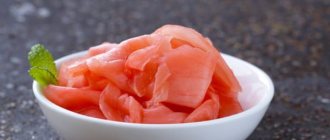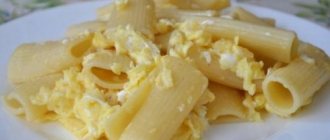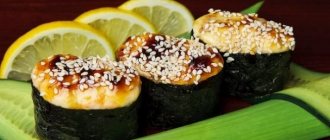Asian cuisine is popular today, but not everyone trusts chain restaurants and fast foods. If you try to eat tasty and healthy and love to cook, it won’t hurt to know how to dilute rice vinegar for rolls and sushi. This recipe is used to make salad dressings.
Natural rice preservative
Beneficial features
Connoisseurs of Japanese cuisine say: the taste and quality of sushi and rolls largely depend on the vinegar dressing for rice. To make the cereal sticky and not bland, it is marinated in the rice preservative sou, an exotic seasoning. More precisely, in a rice vinegar marinade, which contains:
- rice vinegar 3-5%;
- salt;
- sugar;
- water.
The beneficial properties of rice preservative lie not only in taste. There are recipes and diagrams on how to properly drink apple cider vinegar for weight loss without harm to your health. This spice has pronounced tonic properties, as it contains carbohydrates. What else is in rice vinegar:
- amino acids – lysine, alginine, histidine, leucine, valine, phenylalanine;
- microelements beneficial for blood and bones - calcium, potassium, magnesium, iron, phosphorus.
Thanks to this composition, rice preservative is used for medicinal purposes in folk medicine and cosmetology. But it is not always useful; the scope of application of soy sauce is not as wide as that of natural apple vinegar.
Author's note
Agapov Vladislav
Varieties of rice preservative - white, black, red, brown. White vinegar is used to prepare sushi. If you want to experiment, try other color types.
The color of the rice preservative not only changes the appearance of dishes prepared with its addition. It also affects the composition and properties of the seasoning. The tint is achieved by adding various organic additives to the vinegar wort, rather than synthetic dyes.
- White traditional – cleanses the liver, strengthens blood vessels.
- Red – neutralizes free radicals, removes toxins, strengthens the immune system.
- Brown – has an antiseptic effect.
- Black – breaks down and removes harmful cholesterol.
Rice vinegar is low in calories and is included in the diet. In 100 ml. The product contains 18 kcal and up to 0.1 g of carbohydrates. But due to the carbohydrates, it is not recommended for regular use by patients with high blood sugar. If you want to know how to drink apple cider vinegar for diabetes, then read about the benefits - it cleans blood vessels and regulates blood glucose levels. But rice, on the contrary, is undesirable.
The composition and properties of store-bought and homemade preservatives differ
How to dilute store-bought vinegar for sushi and rolls
In order for the rice to acquire the desired texture, not fall apart, but also not stick together, it is important to properly dilute and season the vinegar. Today, rice preservative is available in every supermarket. How to properly use it to make delicious sushi and rolls?
Do you know how to cook sushi and rolls?
Not really
The same methods for preparing dumpling dough with vinegar and sunflower oil work here too - use a tablespoon or a cut glass. The proportions are determined individually, depending on who likes it – more spicy, sour, sweet or neutral. Popular ways to use rice preservative for sushi:
- For a glass of raw rice, take ⅔ glass of vinegar. After cooking, the preservative is poured into the rice, stirred and left for at least half an hour.
- For a glass of rice, take 3 tbsp. marinade rice with sugar and salt and stir after cooking.
- Measure vinegar at the rate of 1 part vinegar to 6 parts rice. Or 1 part vinegar to 4 parts rice.
- 100 ml. vinegar is added to 600 ml of water. This amount of liquid is calculated at 500 mg. raw rice.
- 80 ml. Mix rice preservative to taste with salt, sugar, lemon juice, pour into the pan with rice 3-4 minutes before the end of cooking.
Author's note
Agapov Vladislav
Store-bought rice vinegar contains sugar and salt, and sometimes other additives. The taste of the seasoning differs from one manufacturer to another. Keep this in mind when determining the proportions of ingredients for preparing vinegar marinade for sushi and rolls.
Do you always need to dilute?
It is not necessary to dilute the rice preservative for sushi and rolls. By itself, it is neither spicy nor sour, like a common table seasoning. It's all about personal taste preferences. Those who like a richer taste of sushi do not dilute the vinegar with water; on the contrary, add sugar and lemon juice. But many people prefer to dilute the preservative with water.
Try making sushi in different ways. You can only find your recipe through experience.
How to season with salt and sugar
Not everyone adds salt and sugar to their rice preservative. If the water was added with salt when cooking rice, no salt is added to the marinade. Not everyone likes sugar either; some, on the contrary, add a little lemon juice to the dressing. If you want to prepare the marinade according to the classic recipe, then use 2 tbsp. add 1 tsp of rice preservative. salt and sugar.
Author's note
Agapov Vladislav
For sushi to be as successful as a master sushi master, it is important to cook the rice correctly. For 200 gr. cereals take 300 ml. water. Do not add salt or stir. When the water is completely absorbed, remove the rice from the heat, cover with a lid and leave to cool completely. It should dry out a little. Then add 3 tbsp to it. marinade prepared according to the recipe above.
Vinegar is added to the rice after it has cooled.
LiveInternetLiveInternet
There is hardly a housewife who, at least once in her life, has not tried to cook something unusual for her family.
If you have not yet achieved such a feat, I invite you to join me in wondering about the method of preparing sushi dressing.
Sushi and rolls are part of our daily life. Now you no longer have to go to a restaurant to try these Japanese dishes. All ingredients can be bought in the store. Homemade rolls and sushi are no worse than those you can taste in restaurants. But the necessary products, for example, rice vinegar, may not always be at hand. How to replace rice vinegar or how to prepare it at home - that’s what my article today will be about.
Rice
Special sushi rice can be replaced with regular round grain rice. In no case do we use steamed varieties or rice in bags. They make a nice side dish, but not a sticky rice mass for rolls.
Proportions of water for cooking 1 cup of rice:
- Rice pre-soaked for 1-2 hours – 1:1;
- Dry rice grain - 1.5 cups of water: 1 cup of water.
After the water boils (it will take about 10 minutes), reduce the heat and cook for 15 minutes. It is advisable not to lift the lid. After the time has passed, turn off the heat and let the porridge brew for 20-25 minutes, opening the lid.
Add the dressing to the rice when both the dressing and the rice have cooled a little.
Rice vinegar
This ingredient can rarely be found on the shelves of regular stores due to its high cost. Or maybe there are no specialized stores in your small town or you rarely go to huge supermarkets? Then the question of replacing such vinegar will immediately arise the first time you want to cook an exotic dish.
In such cases, our housewives have learned to replace rice vinegar and generously share recipes on forums or blogs. True, the taste of cooked rice will be slightly different, but we are just learning and may the Japanese forgive us!
Alternative dressing for rice
To prepare an alternative seasoning for rice, we can use apple, wine or grape white vinegar. These types of vinegar essence are quite affordable and inexpensive compared to rice essence.
✔ We use red grape vinegar
The second name is wine vinegar. Contraindications to its use may be increased stomach acidity or an allergy to grapes.
Very often at home, old red wine is used instead of wine vinegar.
- 3 tsp Sahara
- 1 tsp salt
- 4 tbsp. grape vinegar
Place the prepared ingredients in an enamel bowl and bring to a boil. The dressing should not boil. A sign of readiness is the complete dissolution of sugar and salt.
✔ Apple cider vinegar
This type of vinegar essence is one of the highest quality, having a large list of beneficial properties. It is obtained by fermenting sweet apples and apple wine, which makes its taste much milder than ordinary table vinegar.
- 1 tsp Sahara
- 0.5 tsp salt
- 1 tbsp. l. apple cider vinegar
- 1 tbsp. boiled water
Preparation is similar to the previous recipe. Readiness is also determined by the dissolution of dry substances.
✔White grape vinegar
If there are no contraindications to the use of vinegar, then you can try regular table vinegar 6% or white wine. The cooking recipe is similar to the one where red grape tincture was used.
You can also combine vinegar with soy sauce, which will add a special twist to the soak.
- 1 tbsp. l. Sahara
- 2.5 tbsp. l. soy sauce
- 2.5 tbsp. table or white wine vinegar
Heat all ingredients until sugar dissolves.
✔Using lemon juice
Lemon juice is a good option for soaking rice. The fact is that rice vinegar has a very mild taste that is difficult to reproduce. Lemon juice diluted with a small amount of sugar can easily replace it. Very rarely can anyone tell the difference in taste.
- 2 tbsp. l. boiled warm water
- 2 tbsp. lemon juice
- 1 tsp. Sahara
- 0.5 tsp salt
Mix everything until the sugar and salt dissolve. Under no circumstances let the mixture boil.
✔ If there is nori
If you have seaweed in the kitchen (just not kelp, otherwise you'll end up with a bitter-tasting dressing), you can get an almost Japanese version of the dressing.
- 2.5 tbsp. l. any vinegar (table, wine, apple)
- 2.5 tbsp. Sahara
- 0.5 tsp salt
- 1 sheet of nori
Heat all ingredients except seaweed until dissolved and only then add nori. You can take more seaweed - instead of one sheet 2. Chop the seaweed and beat the mixture until smooth.
What not to use
Experienced cooks are strongly against using balsamic vinegar when making rice vinegar. The latter has a bright, specific taste, infused with a bouquet of herbs. It is completely capable of changing the taste of rice, which should have just a hint of sourness.
We use 9% or 6% table vinegars, which are familiar to our kitchens, only as a last resort.
Homemade Rice Vinegar
If you have already learned how to cook sushi at home and have decided that it will become a frequent guest on your menu, you should not use substitute dressings. I suggest making a dressing for rice for future use.
To prepare real rice vinegar at home, we need:
- 1 cup short grain rice
- 250 ml water
- 4 tbsp. Sahara
- Dry yeast – 1/3 teaspoon
Pour the rice into a tray or liter glass container and fill with water.
Pour the rice into a tray or liter glass container and fill with water. Let it stand for 4 hours at room temperature, then put it in the refrigerator overnight.
In the morning, without squeezing out the swollen rice, strain it through a clean cloth. The solution should be a glass, if it is less, add warm boiled water to the full capacity. Add sugar to the resulting solution and dissolve it, stirring everything with a wooden spoon.
Place the rice syrup in a water bath for 20 minutes. We count down the time from the moment when the water under the syrup boils.
Cool the solution, add yeast and let it ferment in a glass jar for a week. Cover the top of the container with clean gauze, thereby allowing access to air, which is necessary for the vital activity of yeast bacteria.
After the solution stops bubbling (the fermentation process is complete), let the rice-sugar solution brew for another month.
After the specified time, filter the resulting mixture again through cheesecloth and boil. Do not be alarmed if the vinegar turns out cloudy - this is its normal condition. If you wish, you can lighten the solution by adding beaten egg white to it while boiling.
The clarification process will require another filtration, after which we pour the homemade rice vinegar into a dark glass bottle and store it in the refrigerator.
How to Add Rice Vinegar to Cooked Rice
After we've made the dressing for the rice and cooked the rice, it's time to combine them. How to do it right?
- In order to combine the dressing and rice, use a wooden spoon and utensils.
- Place the rice in a wooden tub, pour over the dressing and stir with a wooden spatula or spoon.
- Mix carefully, moving the top layer of rice down. Intense stirring will turn the rice into an incomprehensible mess.
After preparing the rice and seasoning, you can start preparing the rolls. And the story about how to wrap sushi and what to use for the filling is the topic of a completely different article.
I hope this collection of secrets for cooking rice and rice vinegar will help you make sushi successfully. Even if you have to replace rare ingredients, let your rolls please your household and become the next conquered peak of culinary art! source
See also:
Rice for sushi - preparing perfect rice without problems
How to cook rice for sushi and rolls
How to dilute acetic acid
How to dilute apple cider vinegar for sushi
True Japanese chefs would consider it blasphemous to use apple preservative. But why not if you don’t have anything else on hand or want to try apple cider vinegar in this dish? Please note that even 3-5% apple vinegar has a richer and brighter taste than rice vinegar. Therefore, dilute with water first. The recipe for making dressing for sushi and rolls with apple cider vinegar is as follows:
- Mix apple cider vinegar and boiled cooled water in the proportion of 1 part water for every 2 parts apple vinegar, if the initial concentration of vinegar is not higher than 5-6%.
- Add ½ tsp per glass of the resulting mixture. salt and sugar, stir.
- Taste and add other spices if desired.
Replace rice vinegar with apple cider vinegar?
Not really
Many people like to add lemon juice to the marinade. Add aromatic herbs and vegetable oil - then you get a universal, tasty and healthy sauce. For example, honey garlic and apple cider vinegar are used to dress Asian salads. The mixture is prepared in advance and refrigerated in a well-sealed container.
If there is no rice vinegar, apple cider vinegar will add piquancy and viscosity to the rice.
How to make rice vinegar
If you can’t find rice preservative in the supermarket or you don’t like store-bought seasonings, you can make your own vinegar from cereals. It should ferment in glass or ceramic containers. Use a wooden spatula or chopsticks to stir.
Ingredients:
- white rice – 300 mg;
- water – 1.2 l;
- sugar - optional;
- dry or fresh yeast - optional.
Preparation:
- Rinse the rice.
- Fill with water and leave overnight.
- Stir, leave for a day at room temperature and refrigerate for another night.
- Stir, strain through cheesecloth.
- Add sugar at the rate of ¼ cup for each cup of liquid.
- Boil water for a water bath in a wide saucepan.
- Place the container with the rice liquid into the pan, let it boil, and cook over low heat for 20 minutes.
- Cool to 40 degrees, add dry yeast at the rate of ¼ tsp. for each 4 glasses of water.
- Stir, cover with gauze and leave to ferment at room temperature for 5-7 days. If the liquid does not ferment well or does not foam, the container should be moved to a warmer place.
- The first stage of fermentation is complete when bubbles no longer form on the surface.
- The liquid is poured into a clean glass jar, the neck is tied with gauze and put in a dark and warm place for 30-40 days.
- The finished vinegar should become transparent, with a pronounced, bright taste. It is poured into a bottle with an airtight lid and stored in the refrigerator. The shelf life will be longer if the vinegar is boiled again after ripening. Then it will not deteriorate for 10-12 months.
Author's note
Agapov Vladislav
The quality and appearance of rice vinegar vary depending on the type of grain used for preparation. Unpolished, non-steamed rice produces vinegar that is more viscous and cloudy. Its taste is more intense. Parboiled and polished rice produces vinegar that is light and clear, but not as tasty.
What can you replace rice vinegar with?
If you don't have rice preservative on hand, table or apple preservative can theoretically be used. If you only have vinegar essence, find out how to dilute vinegar 70 to 9 percent so as not to harm your health. As a last resort, marinate sushi rice in a mixture of water, sugar, salt and lemon juice. Or do without marinating at all.
Finally, a video on how to quickly prepare seasoning for rice for sushi and rolls.
Subtleties of cooking at home and features of rice vinegar
In its popularity, white rice vinegar is compared with the French white wine vinegar so adored by many, and in subtlety and tenderness it even surpasses it.
By the way, white rice vinegar can be replaced with wine or apple vinegar. They are used as an alternative. However, the use of such a product entails the possibility of changing the taste of the dish, which is why it is recommended to dilute the vinegar with water. That’s why the question so often arises: “How to prepare rice vinegar for sushi?”
Crib
- Rice vinegar is an ingredient for making delicious sushi and rolls. The seasoning, along with sugar and salt, is added to boiled rice to give it viscosity, velvety and a piquant flavor.
- To make the sushi tasty and not fall apart, it is important to properly dilute the rice vinegar and marinate the rice in the resulting mixture.
- If you don't have rice vinegar on hand, replace it with regular table vinegar with lemon or apple juice. But the taste of the dish will be different.
- With a little time and effort, make your own delicious natural rice vinegar.
Replacement options
We often come across the question of whether it is possible to replace rice vinegar. Therefore, these options will be useful if the topic of replacing rice vinegar with other products is still relevant for you. You can replace it:
- Four tablespoons of grape vinegar mixed with one teaspoon of salt and three teaspoons of sugar. All this should be put on fire and cooked until the sugar dissolves. It is not advisable to bring the mixture to a boil. After cooking, cool.
- One tablespoon of apple cider vinegar with one teaspoon of sugar and half a teaspoon of salt. To all this you need to add one and a half tablespoons of boiling water. The mixture is stirred until the sugar dissolves, and then added as a dressing to the dish.
- Lemon juice with added sugar.
- Regular 6% white wine, apple cider vinegar (50 ml), mixed with soy sauce (50 ml) and 20 grams of sugar.











